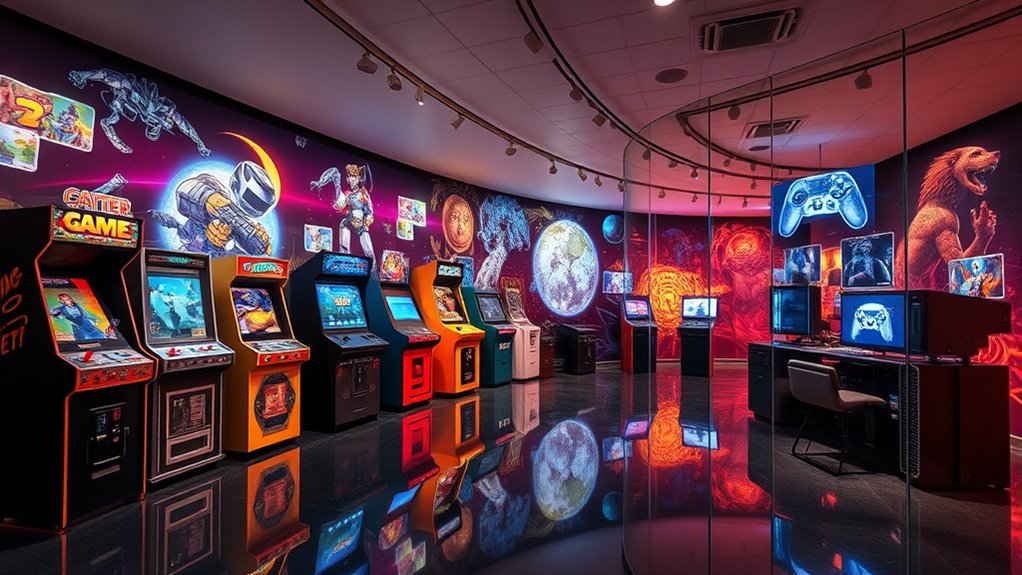You’ve seen how video games have evolved from simple mechanics focused on scoring to immersive storytelling experiences that connect emotionally with players. Advances in technology now let you influence storylines through choices, creating personalized paths and multiple endings. Today, games like “The Last of Us” and “Mass Effect” showcase rich narratives integrated with gameplay, pushing storytelling boundaries. To discover how this ongoing transformation shapes the future of gaming, explore the fascinating developments ahead.
Key Takeaways
- Early video games prioritized gameplay mechanics over narrative, with minimal storytelling elements.
- Technological advances enabled interactive storytelling, allowing player choices to influence story outcomes.
- Narrative design now integrates complex characters, branching paths, and multiple endings for immersive experiences.
- Video games have gained recognition as a sophisticated medium capable of conveying profound stories.
- The evolution continues, with interactive narratives fostering personalized, evolving stories that push storytelling boundaries.

Have you ever wondered how video games have transformed into a powerful storytelling medium? It’s a fascinating journey that highlights how designers have shifted from simple gameplay to immersive worlds filled with compelling stories. Today, interactive narratives are at the heart of many games, allowing you to influence the story through your choices, making each experience unique. This evolution isn’t accidental; it’s the result of deliberate narrative design that aims to engage you on a deeper emotional level. Early video games mostly focused on mechanics and score, with stories taking a backseat. But as technology advanced, developers realized that players crave more than just challenges—they want to feel connected to the characters and worlds they explore. This desire led to the integration of storytelling techniques that mimic those used in traditional media, like films and novels, but with a twist: your actions directly impact the narrative’s progression. This shift toward interactive narratives means you’re no longer just a passive observer but an active participant shaping the outcome. Games like “The Last of Us” or “Mass Effect” exemplify this approach, where your choices determine relationships, story arcs, and even the ending. This level of engagement relies heavily on thoughtful narrative design, which involves carefully crafting storylines, character development, and dialogue that respond dynamically to your decisions. It’s a balancing act—creating a compelling story while maintaining gameplay fluidity. As a player, you’re given the power to explore different paths, uncover hidden lore, and experience multiple endings, making each playthrough feel personal. This design philosophy has transformed storytelling from a linear, predetermined sequence into a flexible, player-driven experience. Moreover, advancements in technology have enabled developers to implement branching narratives and complex character interactions, elevating storytelling to new heights. Now, a game can adapt its story based on your choices, creating a sense of agency that traditional media can’t match. Additionally, the evolution of storytelling techniques in video games reflects a broader recognition that they are not just entertainment but a sophisticated medium capable of conveying profound stories. Your role as a player is central to this experience—you’re not just witnessing a story unfold; you’re actively shaping it. The result is a richer, more engaging form of storytelling that combines the best of interactive media with cinematic storytelling. As you explore these virtual worlds, you become part of an ongoing narrative, one that grows more intricate and meaningful with each decision you make. This ongoing transformation continues to push the boundaries of how stories are told, ensuring that video games remain a dynamic and powerful storytelling medium for years to come.
Frequently Asked Questions
How Do Player Choices Influence Game Narratives?
Your choices directly shape the game’s narrative through player agency, allowing you to influence characters and plot outcomes. As you make decisions, branching narratives emerge, offering multiple story paths and endings. This interactive storytelling makes you feel more immersed and responsible for the story’s direction. By exploring different options, you experience unique storylines, making each playthrough distinct and personalized.
What Are the Future Trends in Interactive Storytelling?
You’ll see future trends in interactive storytelling emphasizing narrative branching and deep character development. As technology advances, expect more personalized experiences where your choices create complex storylines and develop characters uniquely for you. Interactive narratives will become more immersive, blending AI-driven dialogue and dynamic story arcs. This evolution allows you to shape stories actively, making each gameplay feel more like a personalized journey tailored to your decisions and interactions.
How Do Cultural Differences Shape Game Storytelling?
Cultural influences shape game storytelling like a kaleidoscope, blending diverse perspectives into unique narratives. You’ll notice that as developers embrace cultural differences, they foster greater narrative diversity, giving players a richer, more authentic experience. By reflecting local myths, traditions, and values, games become more relatable and immersive. This global tapestry of stories not only broadens your horizons but also deepens your connection with characters across different backgrounds.
What Role Does AI Play in Evolving Narratives?
AI plays a vital role in evolving narratives by enabling procedural generation and narrative branching. You find that AI creates dynamic worlds and storylines that adapt to your choices, making each experience unique. It allows developers to craft complex, responsive plots that change based on your actions, increasing immersion. As AI advances, your gameplay becomes more personalized, and storytelling becomes richer, offering endless possibilities that keep you engaged and enthusiastic for new adventures.
How Have Storytelling Techniques Changed With Virtual Reality?
Think of virtual reality as opening a door to a new dimension where storytelling becomes a living, breathing entity. You’re immersed in environments so vivid, they blur the line between reality and fiction. These techniques focus on sensory engagement, making you feel part of the story rather than just observing it. As a result, narratives evolve into interactive journeys, deepening emotional connections and transforming passive viewing into active participation.
Conclusion
As you navigate the shifting landscape of video games, you see stories unfold like vibrant tapestries woven with pixels and sound. From simple beginnings to immersive worlds, each game invites you to step inside a living canvas of emotion and adventure. The evolution continues, pulling you deeper into worlds where your choices ripple through the story’s fabric. Together, you and these games shape a future where storytelling is as limitless as your imagination.










